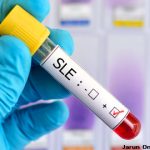Some of the most common ACR classification criteria reported by ILE patients included ANA positivity, immunologic disorder, arthritis and hematologic disorder.
“ILE patients usually had milder forms of disease and so had more cutaneous manifestations or arthritis and less severe manifestations, [such as] renal disease or pericardial effusions,” says Dr. James.
Nearly one in five of the ILE patients had major clinical manifestations, and the rate ran higher in African Americans (25.7%) compared with European Americans (14.9%), according to the article.
Some ILE patients had major clinical manifestations that also appeared in the SLE patients, such as serositis, renal disease, hemolytic anemia and thrombocytopenia. These patients used more medication types and more major immunosuppressants than other ILE patients, according to the article.
Which Medications?
Because no standard treatment recommendations exist for ILE patients, researchers wanted to investigate what medications were used to treat their illness. Study results showed these patients often took the same drugs, such as hydroxychloroquine and corticosteroids, commonly prescribed to classified lupus patients, says Dr. James.
“The thing we found that was slightly surprising was that a subset of individuals who meet three criteria for lupus are receiving immunosuppressive medications or even major immunosuppressive medication …,” she says. “If we knew the ILE patients were not at risk of developing major organ involvement, they might be able to be treated with less toxic medications.”
Information gaps regarding ILE patients is also a research concern, says Dr. James. “Even though our study shows the clinical symptoms the ILE patients have … may be milder than what we think of in systemic lupus, their ILE symptoms as well as their [symptoms] that aren’t part of the classification criteria are definitely impairing their quality of life,” says Dr. James.
Results from serologic testing show ILE patients had fewer autoantibodies and that concentrations were lower when compared with the classified lupus patients. In addition, levels of the B lymphocyte stimulator (BLyS), a protein associated with autoantibody production in lupus, were also lower in ILE patients compared with the SLE group.
A subset of ILE patients (36%) had significantly elevated levels of BLyS, and those patients may warrant closer monitoring for future risk of classified SLE. Many lupus patients have elevated levels of BLyS, but the biomarker previously had not been studied in an ILE population, says Dr. James.
“Maybe that would be another marker that would help rheumatologists when they are evaluating patients with a positive ANA who do not yet meet all the ACR criteria for lupus,” she says.
Rheumatologists must remember the classification criteria were developed for use in clinical trials, not as a diagnostic tool.
Preventing Disease Escalation

Dr. Buyon


